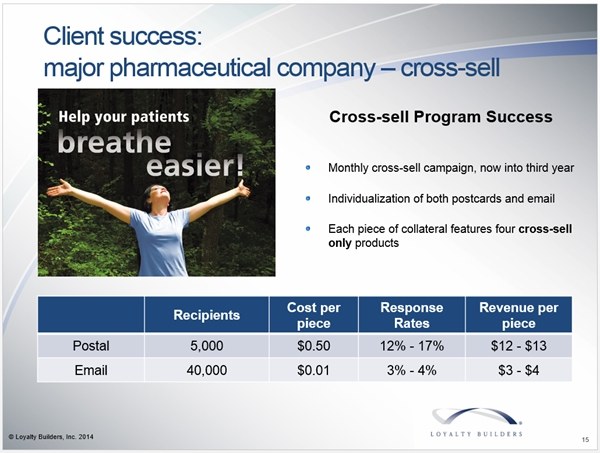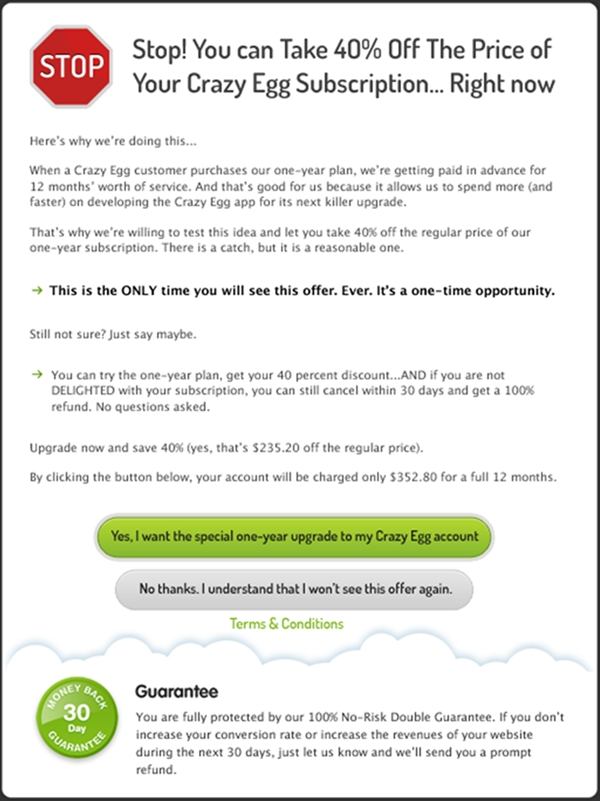In e-commerce, it's hard to increase your conversion rate, even with lots of online traffic. But being able to effectively increase it is among the major factors determining the future success or failure of your business.
Increasing your conversion rate will enhance your return on investment (ROI). You'll need to start by offering a better user experience and using persuasion principles. You should also look to various marketing methods online, such as up-selling, cross-selling, and down-selling.
Up-Selling
Up-selling encourages customers to spend more money than they initially intended. It usually consists of a recommendation of a product or service costing more than the one a customer is considering.
Benefits. Up-selling results in higher regular order totals, exposure to higher margin product/service, increases in revenue. You're also likely to improve customer satisfaction rates because you would be helping customers find products or services suited to their interests. Customers appreciate that you put in time and effort to understanding their wants and needs.
Moreover, up-selling boosts customer lifetime value (CLV). For example, when the auto insurance company GEICO made an up-sell to Chris Yeh, the VP of Marketing for PBWiki, with a 15-minute call, the result was in incremental lifetime revenue of $2,000.
How and when to use. One of the best ways you can up-sell your products or services is by displaying the savings of a bigger purchase—i.e., revealing how much money the customer can save when making the purchase.
Offering free delivery is another good tactic. Some retailers may face financial challenges when paying for shipping, but you can easily remedy that problem by establishing a free-delivery threshold: Determine the average amount customers spend on your products; then, display a catchy message such as "spend another $3.50 to get free delivery."
Example. Eyewear brand Toy Shades was able to increase its conversion rate 113% by showing a "popular in category" section at the product page level and giving upsell suggestions at checkout. According to a case study on Toy Shades, the average order value of the brand rose 16% as a result.

Cross-Selling
Cross-selling is similar to up-selling, except it's used for encouraging customers to buy products or services that aren't directly related to the initial item purchased.
Retailers that use cross-selling often display recommended products or services that were purchased by other customers who bought the same item. Basically, it introduces customers to complementary products.
Benefits. Cross-selling is a great way to not only increase conversion rate but also build customer equity. It helps differentiate your brand from your competitors and improve your market position. Cross-selling enhances customer loyalty and deepens attachment to your business.
How and when to use. One of the most effective cross-selling tactics is bundling and saving packs—i.e., you offer multiple complementary products at a lower, bargain rate. This approach helps boost the amount of money spent on one order. For instance, with a laptop order you could bundle peripherals, such as headphones, laptop tables, computer games, and anti-virus software. Doing so will increase the sale value.
Another way to cross-sell your products or services is by recommending to your customers which other purchases were made by those who bought a similar product. A simple message such as "Customers who bought this also bought..." could help to increase conversion rate.
You may take the cross-selling method even further by allowing customers to personalize their bundles by selecting the exact products they want instead of getting stuck with anything they don't really need.
Example. A case study was conducted by Loyalty Builders on a major pharmaceutical company in 2011. Although sales were growing, the numbers weren't growing as fast as management expected. Many buyers were purchasing from a limited set of SKUs. The company started contacting customers through postcards and emails in a yearlong series of monthly cross-sell campaigns to expand the breadth of products purchased. For every postcard, it brought in revenue of $10; each card cost $0.50 to print and deliver. Each email got a $3 ROI; each email cost around $0.01 to send. Three years later, the results were even better:

Another case study by Quick Pivot found that cross-selling benefited a client that provides information solutions to professionals. By launching a multichannel campaign with a series of emails, the client was able to present numerous ways for contacts to discover products on their own. During the first six months from launch, the revenue per product increased 5%.
Down-Selling
Businesses tend to be familiar with up-selling and cross-selling, which are relatively popular methods for increasing conversion. However, you can also use a technique called down-selling, which is relatively unknown.
Down-selling involves making a one-time offer of a product or service that's less expensive than the one a customer initially considered.
Benefits. It's true that a higher-priced item will have a better profit margin, but down-selling can still be beneficial. If a customer cannot afford a premium product, offering a lower-priced product is a great way to build brand loyalty. Also, you'll still be making a sale even if the customer didn't purchase the item you'd originally wanted her to buy. Down-selling allows you to access more clients with varying budgets.
How and when to use. The best time to use down-selling is when you're very certain the customer isn't going to buy the initial product or service offered. Be careful to avoid introducing the lower-priced offer too early; doing so can confuse potential customers and cause them to decline both offers.
Down-selling is also a good option when you find that sales are dropping because many consumers in your targeted market are unable to afford certain products. That's an ideal time to introduce lower-priced items instead of slashing prices on more expensive ones.
It's also important to keep in mind that when you down-sell, your intent should be to up-sell in the future.
Example. Crazy Egg is a Web analytics service that gives marketers the valuable chance to determine exactly where visitors click on a website. According to a case study by Conversion Rate Experts, the company was able to increase conversion rate and improve lifetime customer value through down-selling. It offered a 30-day free trial and then provided a 40% discount on a one-year plan if a customer canceled within that window. Some 25% of customers accepted the one-time offer. Crazy Egg was able to increase its annual revenue without introducing new services and adding to overhead.

* * *
Marketers should try making use of all three methods when selling their products or services to increase conversion rate and revenue. However, ensure that you're creating a strategy to better understand users' wants and needs. Show up-sell and down-sell offers at the right time to gain long-term customer relationships. Remember that these tactics are beneficial not only to e-commerce websites but also to subscription- and service-based websites.
Implement up-selling, cross-selling, and down-selling techniques in a way that improves customer loyalty and builds your brand image. Carefully plan the offers you're making by using products or services that your customers will actually find useful. Your customers are likely to appreciate the time and effort put into selecting products or services that are truly relevant for them.




